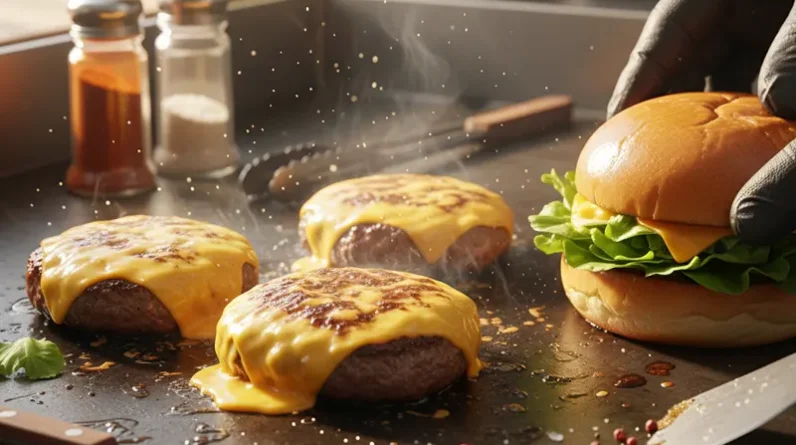
To make exceptional burgers, we’ll help you dodge the most common mistakes. Start with ground beef containing 20% fat content, keeping the meat and equipment cold to prevent smearing during grinding. Form loose, 5-6 ounce patties without overworking the meat, and create a dimple in the center to prevent puffing. Season the exterior with salt and pepper just before cooking, never mixing seasonings into the meat. Cook on a preheated 375-400°F surface and use a meat thermometer to achieve your desired doneness. These fundamental techniques are just the beginning of your journey to mastering the perfect burger.
Selecting the Right Meat
The three most important factors when selecting beef for burgers are fat content, freshness, and grind quality. We recommend choosing ground beef with 20% fat content, as this ratio guarantees juicy, flavorful burgers that won’t dry out during cooking. The meat should be bright red without any gray areas or off-putting odors, indicating peak freshness.
For the best results, we’ll either grind our own beef using chuck and sirloin cuts or ask our butcher for a fresh coarse grind. Single-grind meat produces superior texture compared to pre-packaged options that are often ground multiple times. If we’re grinding at home, we’ll chill the meat and grinder parts to near-freezing temperatures, which prevents smearing and guarantees clean, distinct pieces that form perfectly textured patties.
Proper Patty Formation
Proper patty formation begins with handling the meat as minimally as possible to prevent overworking. We’ll want to gently break apart the ground beef and form loosely packed balls, using about 5-6 ounces per patty for a standard burger.
Let’s create a slight dimple in the center of each patty using our thumb, as this prevents the burger from puffing up during cooking. We’re aiming for patties that are about 3/4 inch thick and roughly 4 inches in diameter. Don’t compress the meat too firmly – we want the patties to hold together but remain tender.
Season the exterior with salt and pepper just before cooking, never mixing seasonings into the meat itself. This technique guarantees a proper crust forms while keeping the interior juicy and perfectly textured.
Temperature Control Matters
Mastering temperature control during burger cooking can mean the difference between a perfectly juicy patty and a dry, overcooked disc. Let’s review the critical temperature control points we need to monitor for ideal results.
– Remove meat from refrigeration 20-30 minutes before cooking to guarantee even heat distribution
– Preheat your cooking surface to 375-400°F (190-204°C) for perfect searing conditions
– Use an instant-read thermometer to check internal temperatures: 125°F for rare, 135°F for medium-rare, 145°F for medium
– Account for carryover cooking by removing burgers 5-10°F below target temperature
– Let burgers rest 3-5 minutes after cooking to allow temperature equilibration and juice redistribution
We’re aiming for consistent, precise temperature management throughout the cooking process. This attention to thermal detail will help us achieve that restaurant-quality burger we’re after.
Seasoning Strategy
Now that we’ve got our temperatures dialed in, successful burger preparation hinges on strategic seasoning. We’ll want to season our ground beef just before forming patties, using 1 teaspoon of kosher salt per pound of meat. Adding salt too early can break down proteins and create a dense, bouncy texture.
For ideal flavor penetration, we’re incorporating freshly ground black pepper and any additional dry seasonings when mixing in the salt. Don’t overwork the meat – gentle mixing is key. We’ll season the exterior of our formed patties again, right before they hit the cooking surface. This two-stage seasoning approach guarantees proper flavor development throughout the burger while maintaining that vital crusty exterior we’re after. Remember: we’re aiming for enhancement, not overwhelming the beef’s natural flavor.
Handling Raw Meat
Safe handling of raw beef requires strict attention to food safety protocols throughout the burger-making process. We’ll focus on essential practices to prevent cross-contamination and guarantee food safety in our kitchen.
– Keep raw beef refrigerated at 40°F or below until ready to use, and never leave it at room temperature for more than 2 hours
– Wash hands thoroughly with soap for at least 20 seconds before and after handling raw meat
– Use separate cutting boards and utensils for raw meat, and sanitize all surfaces that contact the beef
– Maintain a clean workspace by immediately wiping up any meat juices with sanitizing solution
– Check that the internal temperature reaches 160°F using a meat thermometer inserted into the thickest part of the patty
Following these protocols isn’t just about safety—it’s fundamental to maintaining professional standards in burger preparation.
Conclusion
We’ve explored the culinary science behind crafting the perfect beef burger, yet ironically, the secret lies not in complex techniques but in restraint. While we’re tempted to overwork the meat, over-season the patty, and constantly flip our burgers, it’s our ability to step back that creates greatness. Master these fundamentals, and we’ll find that the best burgers come from knowing what not to do.







